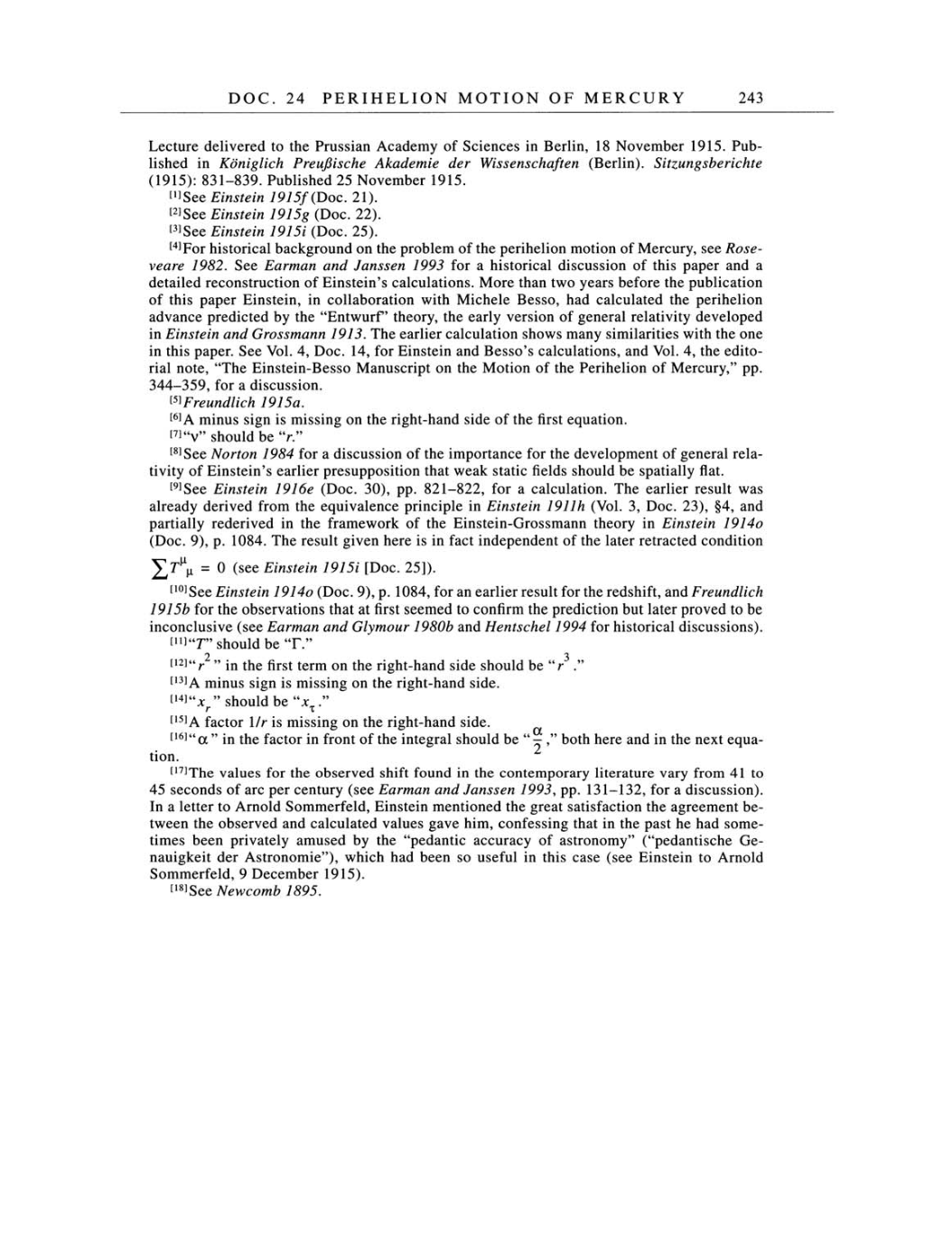DOC. 24 PERIHELION MOTION OF
MERCURY
243
Lecture delivered
to
the Prussian
Academy
of Sciences
in Berlin,
18
November
1915.
Pub-
lished
in
Königlich Preußische
Akademie der
Wissenschaften
(Berlin).
Sitzungsberichte
(1915):
831-839. Published
25
November
1915.
[1]See
Einstein
1915f
(Doc.
21).
[2]See
Einstein
1915g (Doc.
22).
[3]See
Einstein 1915i
(Doc. 25).
[4]For
historical
background
on
the
problem
of the
perihelion
motion of
Mercury,
see
Rose-
veare
1982. See Earman and Janssen
1993
for
a
historical discussion of this
paper
and
a
detailed reconstruction of Einstein's calculations. More than
two years
before the
publication
of this
paper
Einstein, in
collaboration with Michele
Besso,
had calculated the
perihelion
advance
predicted by
the "Entwurf"
theory,
the
early
version of
general relativity developed
in
Einstein and
Grossmann
1913. The earlier calculation shows
many
similarities with the
one
in
this
paper.
See
Vol.
4,
Doc.
14,
for Einstein and Besso's
calculations,
and
Vol.
4,
the edito-
rial
note,
"The Einstein-Besso
Manuscript
on
the Motion of the Perihelion of
Mercury,"
pp.
344-359,
for
a
discussion.
[5]Freundlich
1915a.
[6]A
minus
sign
is
missing
on
the
right-hand
side of the
first
equation.
[7]"v"
should be "r."
[8]See
Norton
1984
for
a
discussion of the
importance
for the
development
of
general
rela-
tivity
of Einstein's earlier
presupposition
that weak static
fields
should be
spatially
flat.
[9]See
Einstein 1916e
(Doc.
30),
pp.
821-822,
for
a
calculation. The earlier result
was
already
derived from the
equivalence principle
in
Einstein
1911h
(Vol.
3,
Doc.
23),
§4,
and
partially
rederived
in
the framework of the Einstein-Grossmann
theory
in
Einstein 1914o
(Doc. 9),
p.
1084.
The result
given
here
is in
fact
independent
of the later retracted condition
ETuu
=
0
(see
Einstein 1915i
[Doc.
25]).
[10]See
Einstein 1914o
(Doc.
9), p. 1084,
for
an
earlier result for the
redshift, and
Freundlich
1915b for the observations that
at
first seemed
to
confirm the
prediction
but later
proved to
be
inconclusive
(see
Earman and
Glymour
1980b and Hentschel
1994
for historical
discussions).
[11]"T"
should be "T."
[12]"r2" in
the first
term
on
the
right-hand
side should
be
"r3."
[13]A
minus
sign
is
missing
on
the
right-hand
side.
[14]"xr"
should
be
"xr."X
r
[15]A
factor 1/r
is missing
on
the
right-hand
side.
[16]"a"
in
the factor
in
front of the
integral
should
be
"a/2,"
both here and
in
the
next equa-
tion.
[17]The
values for the observed shift found
in
the
contemporary
literature
vary
from
41 to
45
seconds of
arc
per century (see
Earman and Janssen
1993,
pp.
131-132,
for
a
discussion).
In
a
letter
to
Arnold
Sommerfeld,
Einstein mentioned the
great
satisfaction the
agreement
be-
tween
the observed and calculated values
gave
him,
confessing
that
in
the
past
he
had
some-
times been
privately
amused
by
the
"pedantic accuracy
of
astronomy" ("pedantische
Ge-
nauigkeit
der
Astronomie"),
which had been
so
useful
in
this
case
(see
Einstein
to
Arnold
Sommerfeld,
9
December
1915).
[18]See
Newcomb
1895.
